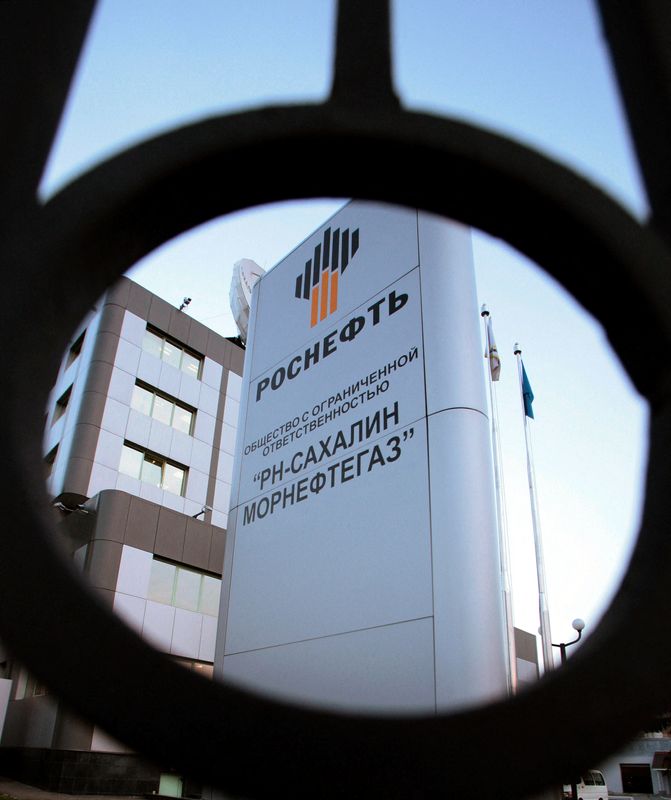Commodities
Exclusive-Russia struggles to sell Pacific oil, 14 tankers stuck – sources, data


© Reuters. FILE PHOTO: The regional office of Russian oil firm Rosneft is seen in the far-eastern city of Yuzhno-Sakhalinsk on Sakhalin Island October 11, 2006. REUTERS/Sergei Karpukhin (RUSSIA)/File Photo
MOSCOW (Reuters) –
• This content was produced in Russia where the law restricts coverage of Russian military operations in Ukraine
More than a dozen tankers loaded with 10 million barrels of Russia’s Sokol grade have been stranded off the coast of South Korea for weeks, so far unsold due to U.S. sanctions and payment issues, according to two traders and shipping data.
The volumes, equating to 1.3 million metric tons, represent more than a month’s production of the Sakhalin-1 project, once a flagship venture of U.S. major Exxon Mobil (NYSE:), which exited Russia after Moscow’s invasion of Ukraine.
Sakhalin-1 was one of the first post-Soviet deals in Russia made under a production sharing agreement. When Exxon Mobil left in 2022, output fell to nearly zero and hasn’t fully recovered since.
Difficulties in selling Sokol grade pose one of the most significant challenges Moscow has faced since the West imposed sanctions and one of the most serious disruptions to Russian oil exports in two years.
Washington has said it wants sanctions to reduce revenues for President Vladimir Putin and his war machine in Ukraine but not to disrupt the flows of Russian energy to global markets.
Last year, the United States imposed sanctions on several vessels and companies involved in transporting Sokol.
As of Friday, 14 vessels loaded with Sokol were stuck around South Korea’s port of Yosu, including 11 Aframax vessels and three very large crude carriers (VLCCs), according to LSEG, Kpler data and traders.
The volume stored in tankers represent 45 days of production from Sakhalin-1, which averages output of 220,000 barrels per day (bpd).
Supertankers (VLCCs) La Balena, Nireta and Nellis with some 3.2 million barrels onboard (430,000 metric tons), currently near South Korea’s Yosu, are acting as a floating storage for the Russian oil grade, Reuters sources said and Kpler and LSEG shipping data show.
The VLCCs previously accepted oil from several Aframax vessels via ship-to-ship, the data showed. Supplying oil volumes from smaller ships to bigger ones can save on freight.
The rest of the Sokol oil loaded from November to January is stored on smaller Aframax vessels (able to carry 500,000-800,000 barrels) – Krymsk, NS Commander, Sakhalin Island, Liteyny Prospect, NS Century, NS Lion, NS Antarctic, Jaguar, Vostochny Prospect, Pavel Chernysh and Viktor Titov.
Shipments of Sokol to the Indian Oil Corp have been delayed by payment problems, forcing India’s biggest refiner to draw from its inventories and buy more oil from the Middle East.
A source close to IOC said the company did not expect to receive any Sokol shipments soon due to a disagreement over which currency would be used to pay for it.
IOC is the only state refiner that has an annual deal to buy a variety of Russian grades, including Sokol, from Russian oil major Rosneft. IOC and Rosneft did not reply to Reuters requests for comment.
Commodities
Oil prices rise; U.S. crude inventories plunge, Russia-Ukraine truce eyed
Commodities
India’s Reliance to stop buying Venezuelan oil over US tariffs, sources say
Commodities
Oil prices climb on Venezuela supply worries

 Forex3 years ago
Forex3 years agoForex Today: the dollar is gaining strength amid gloomy sentiment at the start of the Fed’s week

 Forex3 years ago
Forex3 years agoUnbiased review of Pocket Option broker

 Forex3 years ago
Forex3 years agoDollar to pound sterling exchange rate today: Pound plummeted to its lowest since 1985

 Forex3 years ago
Forex3 years agoHow is the Australian dollar doing today?

 Cryptocurrency3 years ago
Cryptocurrency3 years agoWhat happened in the crypto market – current events today

 World3 years ago
World3 years agoWhy are modern video games an art form?

 Commodities3 years ago
Commodities3 years agoCopper continues to fall in price on expectations of lower demand in China

 Economy3 years ago
Economy3 years agoCrude oil tankers double in price due to EU anti-Russian sanctions























